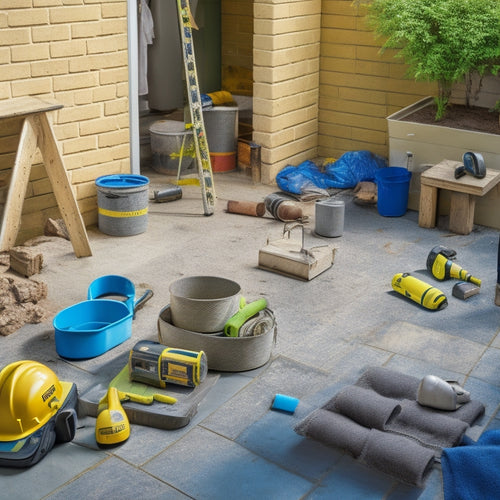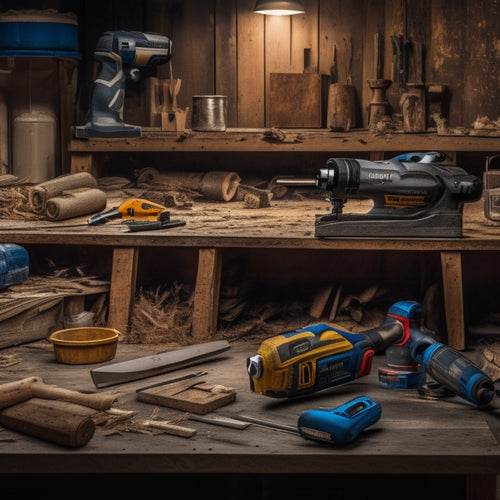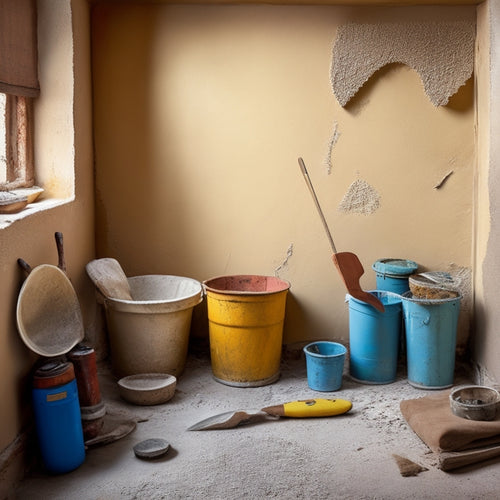
Optimal Times for Perfect Plastering in Home Renovation
Share
When planning a home renovation that involves plastering, you need to get the timing right, as improper timing can lead to weak structures, uneven finishes, and costly rework. To achieve peak results, mix cement within 30 minutes to 1 hour, and guarantee ideal temperatures between 50°F to 70°F (10°C to 21°C). Additionally, maintain humidity levels between 40% and 60%, and provide good air movement for even drying. Avoid extreme weather conditions, and consider the benefits of morning mixing versus afternoon mixing. By understanding these key factors, you'll be better equipped to achieve a high-quality, long-lasting plaster finish that meets your renovation goals.
Key Takeaways
• Ideal mixing and application temperatures range from 50°F to 70°F (10°C to 21°C) for thorough hydration and proper setting.
• Mixing should be completed within 30 minutes to 1 hour to ensure strength, and overmixing should be avoided to prevent porous structures.
• Morning mixing is preferred due to cooler temperatures and lower humidity, allowing for better workability and a smoother finish.
• Avoid plastering during extreme weather conditions like direct sunlight, strong winds, and freezing temperatures, which can cause cracks and uneven finishes.
• Schedule plastering projects during spring or fall when temperatures are mild, and take necessary precautions like providing shade and using windbreaks.
Cement Mixing Time and Temperature
When mixing cement, you should aim to complete the process within 30 minutes to an hour, as excessive mixing time can lead to a weaker final product. Ideal temperatures for mixing range from 50°F to 70°F (10°C to 21°C). This timeframe allows for thorough hydration of the cement particles, guaranteeing a strong bond between the aggregate and the binder.
It's important to adopt efficient mixing techniques to achieve the right consistency and prevent segregation of the mixture. Overmixing can lead to a porous and weak structure, while under-mixing may result in an uneven finish.
During the mixing process, it's vital to follow the correct curing methods to prevent premature drying and guarantee proper hydration. Curing involves maintaining the right level of moisture and temperature to allow the cement to set and harden.
You can use techniques like misting, covering, or applying a curing compound to achieve the best curing conditions. By controlling the mixing time and temperature, and adopting the right mixing techniques and curing methods, you can create a strong, durable, and long-lasting plaster that meets the desired standards for your home renovation project.
Ideal Environmental Conditions
You'll need to make certain the environmental conditions are ideal for plastering, as temperature, humidity, and air movement can greatly impact the final product's quality and durability.
The ideal temperature range for plastering is between 10°C and 20°C (50°F to 68°F), with a preferable temperature of 15°C (59°F). This allows for the perfect plaster consistency, which is vital for a smooth finish.
Humidity levels should be maintained between 40% and 60% to prevent excessive water evaporation, which can lead to inconsistent plastering. Air movement is also essential, as it helps to remove excess moisture and promote even drying. Guarantee good ventilation by opening windows or using fans to maintain a gentle airflow.
Proper surface preparation is also critical in ideal environmental conditions. The surface should be clean, dry, and free of dust, oil, or other contaminants that can affect plaster adhesion.
A well-prepared surface, combined with preferable environmental conditions, will result in a high-quality, long-lasting plaster finish. By controlling these factors, you'll be able to achieve a professional-looking finish that meets your renovation goals.
Morning Vs Afternoon Mixing
Mix your plaster in the morning, as the cooler temperatures and lower humidity help to slow down the setting process, allowing for a more workable consistency and better finish. This is because morning benefits include a slower setting time, giving you more time to work with the plaster and achieve a smooth, even finish.
In addition, the lower humidity reduces the risk of excessive water evaporation, which can lead to a weaker bond between the plaster and the substrate.
In contrast, mixing plaster in the afternoon can be problematic. Afternoon drawbacks include higher temperatures and humidity, which accelerate the setting process, making it more challenging to work with the plaster.
This can result in a finish that's uneven, rough, or even cracked. Moreover, the increased humidity can lead to excessive water absorption, causing the plaster to shrink and crack as it dries.
Avoiding Extreme Weather Conditions
Three key extreme weather conditions to avoid when plastering are direct sunlight, strong winds, and freezing temperatures. These conditions can greatly impact the quality of your plastering job, making it essential to plan your project accordingly.
When you're planning your plastering project, make sure to avoid these extreme weather conditions:
-
Direct sunlight can cause the plaster to dry too quickly, leading to cracks and uneven finishes.
-
Strong winds can disrupt the plastering process, making it difficult to achieve a smooth finish.
-
Freezing temperatures can slow down the curing times, prolonging the entire plastering process.
Additionally, consider the following factors when planning your project:
-
Avoid plastering during peak summer months when temperatures are high.
-
Schedule your project during the spring or fall when temperatures are mild.
-
If you must plaster during extreme weather conditions, take necessary precautions, such as providing shade or using windbreaks.
-
Be prepared to adjust your plastering techniques and curing times according to the weather conditions.
-
Consider consulting with a professional if you're unsure about the best approach for your specific project.
Working With Cement in Humidity
When working with cement in humid environments, it's crucial to account for the increased water absorption rate, which can greatly impact the plaster's strength and durability.
You'll need to adjust your mixing ratio and application techniques to compensate for the humidity effects. In humid conditions, cement absorbs more water, leading to a weaker bond between the cement and aggregate. This can result in a lower compressive strength and increased risk of cracks.
To mitigate these effects, focus on moisture management during the mixing and application process. Use a mixing ratio that takes into account the humidity level, and avoid over-mixing, which can lead to excessive water absorption.
Apply the plaster in thin layers, allowing each layer to set before applying the next. This will help to reduce the impact of humidity on the plaster's strength.
Additionally, consider using additives that improve the cement's water resistance, such as silica fume or fly ash. By taking these steps, you can guarantee a strong, durable plaster finish even in humid environments.
Frequently Asked Questions
Can I Reuse Old Plaster or Do I Need to Buy New?
When deciding whether to reuse old plaster or buy new, you'll want to assess the plaster quality first.
Check for signs of deterioration, such as cracks or water damage.
If the plaster is still in good condition, reusing it can lead to significant cost savings.
However, if you notice any defects, it's best to purchase new plaster to guarantee a strong, durable finish.
How Long Does It Take for Plaster to Fully Harden?
You're wondering how long it takes for plaster to fully harden.
Well, it typically takes around 24 to 48 hours for the initial set, but full curing can take up to 28 days, depending on factors like humidity and temperature.
High humidity can slow down the curing process, while ideal conditions can speed it up.
You'll know it's fully cured when it's hardened and doesn't scratch easily.
What Safety Gear Should I Wear When Working With Plaster?
Did you know that over 20,000 construction workers suffer from silica-related diseases annually?
When working with plaster, you must prioritize plastering safety.
Wear protective equipment such as a dust mask, safety goggles, and gloves to prevent skin and eye irritation. A full-face respirator is also essential to filter out silica particles.
Don't forget a hat, long sleeves, and pants to cover your skin.
Can I Plaster Over Existing Paint or Wallpaper?
When deciding whether to plaster over existing paint or wallpaper, you'll need to take into account the surface preparation.
If the existing finish is in good condition, you might get away with a light sanding and cleaning.
However, if it's peeling, flaking, or uneven, you'll need to strip it back to guarantee proper plaster adhesion.
In either case, a bonding agent can help create a strong bond between the old surface and new plaster.
How Do I Clean My Tools After Using Plaster?
When you're done plastering, you'll want to prioritize tool maintenance to guarantee your equipment stays in top shape.
For effective plaster cleanup, start by scraping off excess plaster from your tools using a putty knife or trowel.
Then, wash them with soap and warm water to remove any remaining residue.
Dry your tools thoroughly to prevent rust or corrosion.
Regularly cleaning your tools will extend their lifespan and maintain their performance for future projects.
Conclusion
As you wrap up your plastering project, remember that ideal timing is essential.
You've carefully mixed cement, considered environmental conditions, and avoided extreme weather.
Now, ask yourself: would you rather have a beautifully finished wall or a costly re-do?
By following these guidelines, you'll be well on your way to achieving a flawless, long-lasting finish.
Related Posts
-

7 Patio Safety Tips for DIY Renovation Projects
As you begin your DIY patio renovation project, prioritize safety by evaluating the worksite for tripping hazards and...
-

10 Best Power Tools to Buy for Home Renovation
To tackle your home renovation project efficiently, you'll need the right power tools for the job. A cordless drill f...
-

Stucco Patching Material Checklist for Home Renovation
You'll need a range of essential tools, including a putty knife, wire brush, hawk or flat trowel, level, and straight...


